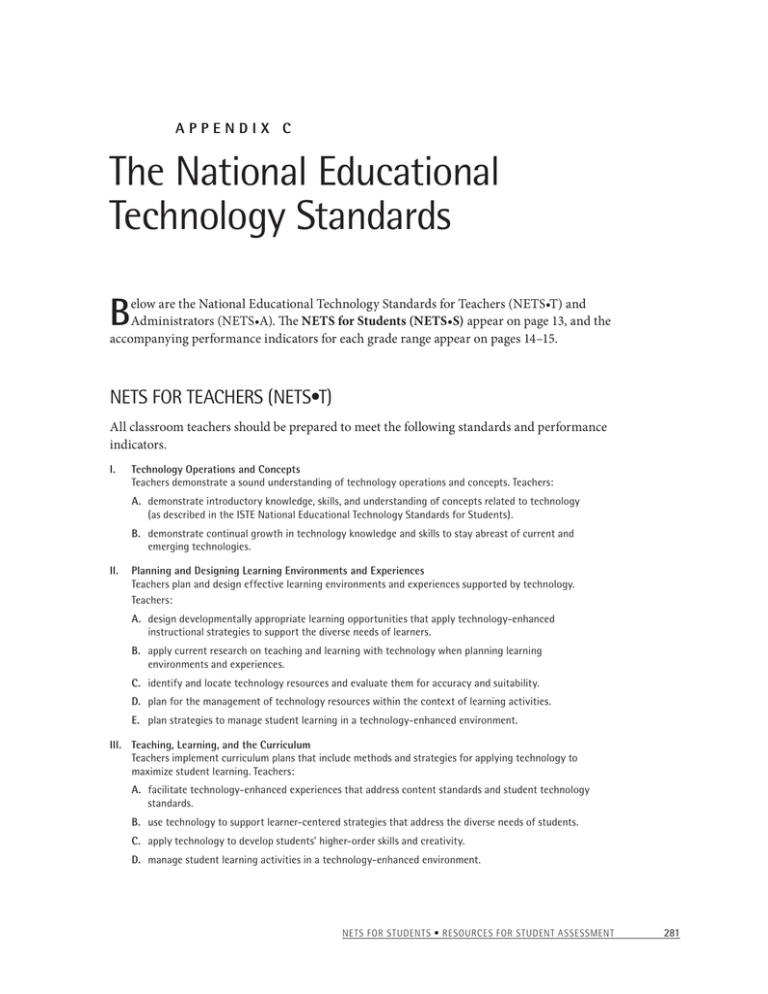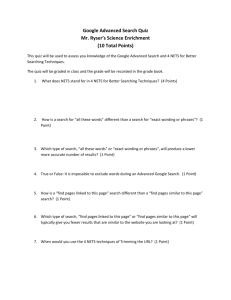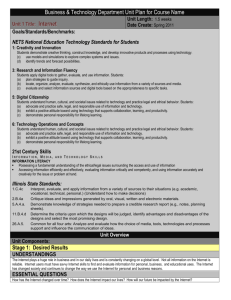The National Educational Technology Standards B
advertisement

APPENDIX C The National Educational Technology Standards B elow are the National Educational Technology Standards for Teachers (NETS•T) and Administrators (NETS•A). The NETS for Students (NETS•S) appear on page 13, and the accompanying performance indicators for each grade range appear on pages 14–15. NETS for Teachers (NETS•T) All classroom teachers should be prepared to meet the following standards and performance indicators. I. Technology Operations and Concepts Teachers demonstrate a sound understanding of technology operations and concepts. Teachers: A. demonstrate introductory knowledge, skills, and understanding of concepts related to technology (as described in the ISTE National Educational Technology Standards for Students). B. demonstrate continual growth in technology knowledge and skills to stay abreast of current and emerging technologies. II. Planning and Designing Learning Environments and Experiences Teachers plan and design effective learning environments and experiences supported by technology. Teachers: A. design developmentally appropriate learning opportunities that apply technology-enhanced instructional strategies to support the diverse needs of learners. B. apply current research on teaching and learning with technology when planning learning environments and experiences. C. identify and locate technology resources and evaluate them for accuracy and suitability. D. plan for the management of technology resources within the context of learning activities. E. plan strategies to manage student learning in a technology-enhanced environment. III. Teaching, Learning, and the Curriculum Teachers implement curriculum plans that include methods and strategies for applying technology to maximize student learning. Teachers: A. facilitate technology-enhanced experiences that address content standards and student technology standards. B. use technology to support learner-centered strategies that address the diverse needs of students. C. apply technology to develop students’ higher-order skills and creativity. D. manage student learning activities in a technology-enhanced environment. NE TS FOR STUDENTS • RESOURCES FOR STUDENT A SSESSMENT 281 Appendix C • The National Educational Technology Standards IV. Assessment and Evaluation Teachers apply technology to facilitate a variety of effective assessment and evaluation strategies. Teachers: A. apply technology in assessing student learning of subject matter using a variety of assessment techniques. B. use technology resources to collect and analyze data, interpret results, and communicate findings to improve instructional practice and maximize student learning. C. apply multiple methods of evaluation to determine students’ appropriate use of technology resources for learning, communication, and productivity. V. Productivity and Professional Practice Teachers use technology to enhance their productivity and professional practice. Teachers: A. use technology resources to engage in ongoing professional development and lifelong learning. B. continually evaluate and reflect on professional practice to make informed decisions regarding the use of technology in support of student learning. C. apply technology to increase productivity. D. use technology to communicate and collaborate with peers, parents, and the larger community in order to nurture student learning. VI. Social, Ethical, Legal, and Human Issues Teachers understand the social, ethical, legal, and human issues surrounding the use of technology in PK–12 schools and apply that understanding in practice. Teachers: A. model and teach legal and ethical practice related to technology use. B. apply technology resources to enable and empower learners with diverse backgrounds, characteristics, and abilities. C. identify and use technology resources that affirm diversity. D. promote safe and healthy use of technology resources. E. facilitate equitable access to technology resources for all students. NETS for Administrators (NETS•A) All school administrators should be prepared to meet the following standards and performance indicators. These standards are a national consensus among educational stakeholders regarding what best indicates effective school leadership for comprehensive and appropriate use of technology in schools. I. Leadership and Vision—Educational leaders inspire a shared vision for comprehensive integration of technology and foster an environment and culture conducive to the realization of that vision. Educational leaders: A. facilitate the shared development by all stakeholders of a vision for technology use and widely communicate that vision. B. maintain an inclusive and cohesive process to develop, implement, and monitor a dynamic, longrange, and systemic technology plan to achieve the vision. C. foster and nurture a culture of responsible risk taking and advocate policies promoting continuous innovation with technology. D. use data in making leadership decisions. E. advocate for research-based effective practices in use of technology. 282NE TS FOR STUDENTS • RESOURCES FOR STUDENT A SSESSMENT The National Educational Technology Standards • Appendix C F. advocate, on the state and national levels, for policies, programs, and funding opportunities that support implementation of the district technology plan. II. Learning and Teaching—Educational leaders ensure that curricular design, instructional strategies, and learning environments integrate appropriate technologies to maximize learning and teaching. Educational leaders: A. identify, use, evaluate, and promote appropriate technologies to enhance and support instruction and standards-based curriculum leading to high levels of student achievement. B. facilitate and support collaborative technology-enriched learning environments conducive to innovation for improved learning. C. provide for learner-centered environments that use technology to meet the individual and diverse needs of learners. D. facilitate the use of technologies to support and enhance instructional methods that develop higher-level thinking, decision-making, and problem-solving skills. E. provide for and ensure that faculty and staff take advantage of quality professional learning opportunities for improved learning and teaching with technology. III. Productivity and Professional Practice—Educational leaders apply technology to enhance their professional practice and to increase their own productivity and that of others. Educational leaders: A. model the routine, intentional, and effective use of technology. B. employ technology for communication and collaboration among colleagues, staff, parents, students, and the larger community. C. create and participate in learning communities that stimulate, nurture, and support faculty and staff in using technology for improved productivity. D. engage in sustained, job-related professional learning using technology resources. E. maintain awareness of emerging technologies and their potential uses in education. F. use technology to advance organizational improvement. IV. Support, Management, and Operations—Educational leaders ensure the integration of technology to support productive systems for learning and administration. Educational leaders: A. develop, implement, and monitor policies and guidelines to ensure compatibility of technologies. B. implement and use integrated technology-based management and operations systems. C. allocate financial and human resources to ensure complete and sustained implementation of the technology plan. D. integrate strategic plans, technology plans, and other improvement plans and policies to align efforts and leverage resources. E. implement procedures to drive continuous improvements of technology systems and to support technology-replacement cycles. V. Assessment and Evaluation—Educational leaders use technology to plan and implement comprehensive systems of effective assessment and evaluation. Educational leaders: A. use multiple methods to assess and evaluate appropriate uses of technology resources for learning, communication, and productivity. B. use technology to collect and analyze data, interpret results, and communicate findings to improve instructional practice and student learning. C. assess staff knowledge, skills, and performance in using technology and use results to facilitate quality professional development and to inform personnel decisions. D. use technology to assess, evaluate, and manage administrative and operational systems. NE TS FOR STUDENTS • RESOURCES FOR STUDENT A SSESSMENT 283 Appendix C • The National Educational Technology Standards VI. Social, Legal, and Ethical Issues—Educational leaders understand the social, legal, and ethical issues related to technology and model responsible decision making related to these issues. Educational leaders: A. ensure equity of access to technology resources that enable and empower all learners and educators. B. identify, communicate, model, and enforce social, legal, and ethical practices to promote responsible use of technology. C. promote and enforce privacy, security, and online safety related to the use of technology. D. promote and enforce environmentally safe and healthy practices in the use of technology. E. participate in the development of policies that clearly enforce copyright law and assign ownership of intellectual property developed with district resources. This material was originally produced as a project of the Technology Standards for School Administrators Collaborative. 284NE TS FOR STUDENTS • RESOURCES FOR STUDENT A SSESSMENT





